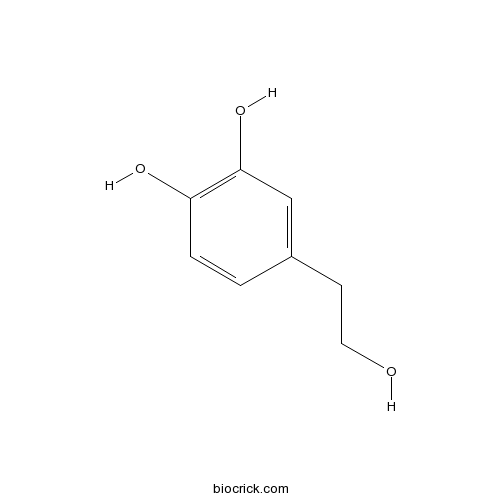Diospyros kaki
Diospyros kaki
1. The products in our compound library are selected from thousands of unique natural products; 2. It has the characteristics of diverse structure, diverse sources and wide coverage of activities; 3. Provide information on the activity of products from major journals, patents and research reports around the world, providing theoretical direction and research basis for further research and screening; 4. Free combination according to the type, source, target and disease of natural product; 5. The compound powder is placed in a covered tube and then discharged into a 10 x 10 cryostat; 6. Transport in ice pack or dry ice pack. Please store it at -20 °C as soon as possible after receiving the product, and use it as soon as possible after opening.
Natural products/compounds from Diospyros kaki
- Cat.No. Product Name CAS Number COA
-
BCN5871
2-(3,4-Dihydroxyphenyl)ethanol10597-60-1
Instructions

-
BCN4546
4-Hydroxybenzoic acid99-96-7
Instructions

Quality by design compliant strategy for the development of a liquid chromatography-tandem mass spectrometry method for the determination of selected polyphenols in Diospyros kaki.[Pubmed: 30029776]
Diospyros kaki fruits possess great beneficial properties for human health due to their strong antioxidant and antiradical activities related to the high level of bioactive compounds and particularly polyphenols. In this paper a rapid and efficient liquid chromatography-tandem mass spectrometry method for the determination of 38 polyphenolic compounds in Diospyros kaki flesh was developed. The optimization of the chromatographic method was performed applying a Quality by Design approach, which is unexplored in the field of food analysis. The Critical Method Attributes (CMAs) were the critical resolutions of some isobaric compounds and analysis time. The Critical Methods Parameters (CMPs) were related to the characteristics of both the mobile phase and the column: flow rate, temperature, starting organic phase concentration of the mobile phase, formic acid percentage in the eluents, type of organic solvent in the mobile phase and gradient of organic eluents. The effects of the CMPs on the CMAs were evaluated by experimental design, at first carrying out a screening phase by an asymmetric screening matrix and then applying Response Surface Methodology by a Doehlert Design. The quadratic polynomial models postulated to link the CMAs to CMPs were calculated and the Method Operable Design Region was identified with the aid of Monte Carlo simulations as the multidimensional combination of the CMPs that satisfied the requirements for the CMAs with a probability ≥90%. The developed method was applied to real samples obtained by the extraction of Diospyros kaki flesh from two different cultivars (Rojo Brillante and Kaki Tipo), making it possible to obtain extensive information on their polyphenolic profiles.
Triterpene saponins with neuroprotective effects from the leaves of Diospyros kaki Thunb.[Pubmed: 29959052]
None
Biosynthesis of palladium nanoparticles using Diospyros kaki leaf extract and determination of antibacterial efficacy.[Pubmed: 29902099]
Palladium, the building block of white gold, has been found to exhibit extraordinary properties in nanotechnological products produced in recent years. The most prominent feature of palladium is adsorbing and storing high levels of hydrogen. Therefore, the demand for palladium in the world increased excessively in the 2000s. In the present study, palladium nanoparticles (PdNPs) were biosynthesized by the extract of Diospyros kaki leaves as bio-stimulator. D. kaki, also called persimmon, was collected in a local area in Istanbul Turkey. PdNP formation was screened by analyzing UV-Vis spectrophotometer at 250-550 nm. The nanoparticles were characterized by scanning electron microscope which revealed that the biosynthesized PdNPs were in sizes ranging from 50 to 120 nm. Fourier transform infrared spectroscopy applied on both D. kaki leaf extract and PdNPs was used to decide on the reactive groups managing the reduction of the biosynthesized nanoparticles. Also, the PdNPs showed reasonably proficient antibacterial efficacy for both Escherichia coli and Staphylococcus aureus and the zones of inhibition were found as 18 and 10.5 mm, respectively.


